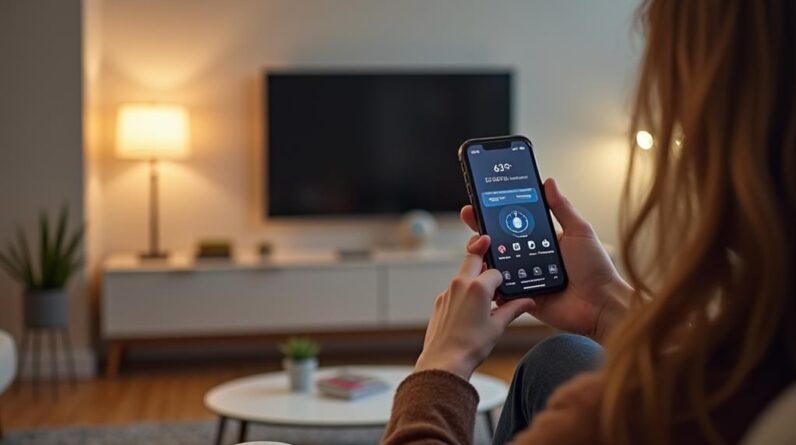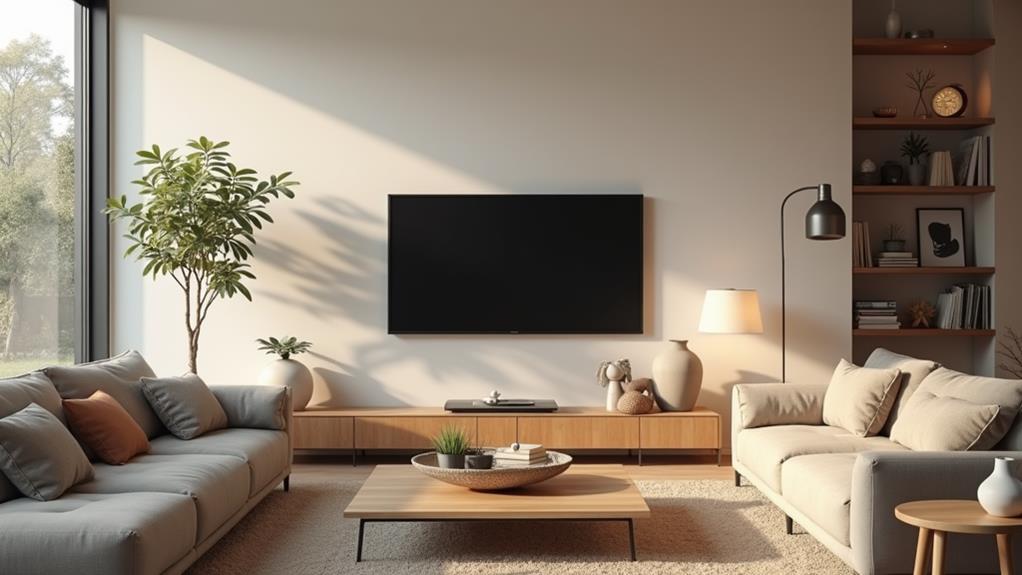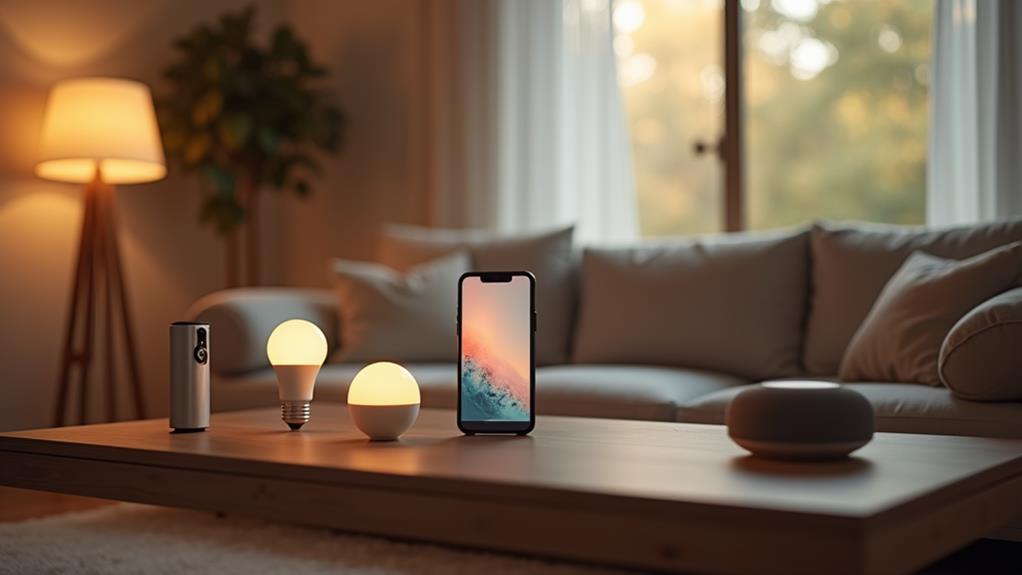
Building a smart home on a budget is easier than you might think. Start by focusing on essential areas like lighting, security, and temperature control. Research affordable brands and consider starter kits for discounted prices. Prioritize devices compatible with your chosen ecosystem (Amazon Alexa, Google Home, or Apple HomeKit). DIY installation can save you money, but always follow manufacturer instructions for safety. Maximize automation with budget-friendly voice control devices, smart lights, and energy-saving thermostats. Look for deals during major sales events to stretch your budget further. With careful planning and smart choices, you'll create a tech-savvy home without breaking the bank.
Planning Your Smart Home Journey
Venturing on your smart home journey requires careful planning to make the most of your budget. To kick off your smart home project, prioritize the features and devices that matter most to you. Focus on essential areas like lighting, security, and temperature control to create a foundation for your connected home.
Next, establish a realistic budget that accounts for devices, hubs, and potential installation or subscription fees. This financial roadmap will guide your decisions and prevent overspending as you build your smart home system.
Research is vital when selecting a primary smart home ecosystem. Compare options like Amazon Alexa, Google Home, or Apple HomeKit to find the one that best aligns with your needs and existing devices. Opt for an ecosystem that offers compatibility with a wide range of smart home devices to guarantee seamless integration and future-proof your setup.
When choosing devices, look for bundles or starter kits that offer multiple components at a discounted price. This approach not only saves money but also simplifies the setup process. Additionally, prioritize devices with open APIs and platforms that allow for customization and integration, guaranteeing your smart home technology remains flexible and adaptable to future innovations.
Choosing Budget-Friendly Smart Devices
Smart home enthusiasts on a budget can rejoice: there are plenty of affordable options to kickstart your connected home journey. When choosing budget-friendly smart devices, consider brands like Eufy Security and Wyze. These companies offer indoor and outdoor security cameras without subscriptions, providing a cost-effective way to enhance your home's safety.
For those invested in the Apple ecosystem, the HomePod mini serves as an affordable hub for HomeKit integration. Priced at $94.99, it's a versatile voice assistant that can control your smart home devices. Complement it with the Yale Assure Lock SL with HomeKit module, a keyless smart lock that seamlessly integrates with your Apple setup.
Don't overlook the importance of a smart doorbell in your DIY smart home. The Eufy Wireless Video Doorbell, available for $89.99, offers a battery-powered solution without monthly fees. This affordable smart home device enhances your home's security while keeping costs low.
Essential Smart Home Components

At the core of any smart home setup are a few essential components that provide the foundation for automation and convenience. A smart home hub, like Amazon Echo or Google Home, serves as the central control unit, allowing you to manage your devices through voice commands and remote access.
Smart plugs are an affordable way to transform ordinary appliances into smart ones, offering scheduling and remote control capabilities for under $25. Smart bulbs, starting at $15, provide adjustable lighting options and can be controlled via voice or mobile apps.
For climate control, smart thermostats learn your preferences and optimize heating and cooling, potentially saving you money on energy bills. These devices, ranging from $150 to $250, often include features like geofencing and remote access.
To enhance your home security, smart cameras offer real-time monitoring, motion detection, and alerts. With options available for under $50, they're an accessible addition to your smart home network.
DIY Installation and Setup
Once you've chosen your smart home components, it's time to roll up your sleeves and tackle the installation process. Before diving in, confirm all devices are compatible with your Wi-Fi network and each other. Start by setting up your central hub, such as a smart speaker or display, which will serve as the command center for your smart home ecosystem.
When installing smart plugs, outlets, and switches, prioritize safety by turning off the power at the main electrical panel. Follow the manufacturer's instructions meticulously, leveraging their apps for seamless setup. To maximize your smart home's potential:
- Implement voice control through popular voice assistants
- Create custom schedules for automated routines
- Explore advanced features like geofencing and scene creation
Consider establishing a dedicated smart home network to bolster security and minimize the risk of cyber threats. This approach segregates your connected devices from your primary network, adding an extra layer of protection.
Maximizing Automation on a Budget

To maximize automation on a budget, prioritize devices that offer the most bang for your buck. Focus on smart home essentials that'll substantially impact your daily life without breaking the bank. Start with budget-friendly voice control devices like Amazon Echo Dot or Google Nest Mini, which can serve as hubs for your smart home ecosystem.
Invest in smart lights with motion sensors, as they provide both convenience and energy savings. Look for brands like Wyze or Sengled, which offer affordable options without monthly fees. For security features, consider Eufy Security cameras or Ring doorbells, which provide robust functionality without costly subscriptions.
To optimize energy usage, install smart thermostats and smart plugs. These devices can help you monitor and control your home's energy consumption, leading to long-term savings. When shopping for smart home devices, keep an eye out for deals during major sales events like Prime Day and Black Friday.
Remember to carefully evaluate bundles and avoid unnecessary subscriptions. By focusing on devices that offer free features and don't require ongoing payments, you'll create a budget-friendly smart home that maximizes automation without compromising on innovation or functionality.
Expanding Your Smart Home Ecosystem
Building upon your initial smart home setup, it's time to expand your ecosystem strategically. When adding new devices, prioritize compatibility with your existing system, whether it's Amazon Alexa, Google Home, or Apple HomeKit. This approach guarantees seamless integration and maximizes functionality across your smart home.
To get the most value from your investment, focus on multi-purpose devices like smart displays with built-in cameras and speakers. These versatile gadgets serve multiple functions while streamlining your setup. Additionally, consider subscription-free options or devices with limited free features, such as Eufy Security and Wyze, to keep long-term costs down.
To stretch your budget further, follow these tips:
- Look for bundle deals on smart home devices
- Take advantage of sales events like Prime Day and Black Friday
- Research devices that offer free basic functionality
As you expand, prioritize devices that enhance your daily life and security. Smart plugs, security cameras, and doorbells are excellent additions that integrate well with most ecosystems. By carefully selecting compatible and cost-effective devices, you'll create a robust, innovative smart home without breaking the bank.
Conclusion
You've now got the knowledge to create an impressive smart home without breaking the bank. Remember, start small and expand gradually. Focus on devices that'll make the biggest impact on your daily life. Don't be afraid to mix brands or try DIY solutions. With careful planning and smart choices, you'll soon enjoy the convenience and efficiency of a connected home. Keep learning, stay up-to-date with new technologies, and have fun customizing your smart home experience.
As an Amazon Associate I earn from qualifying purchases.







